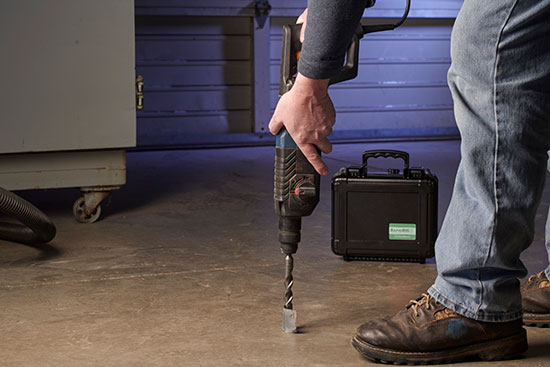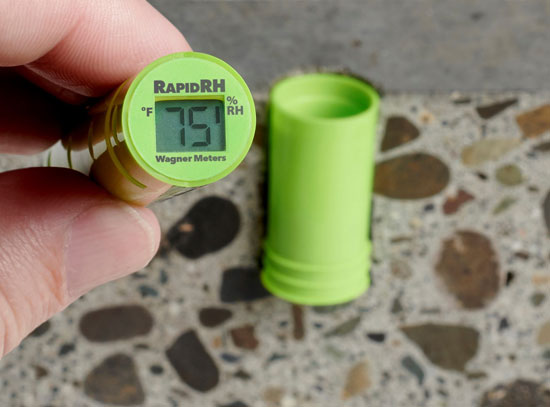Why RH Testing Is the Best Choice for Concrete

RH testing requires drilling holes in concrete, but you don’t have to worry about damaging the heating coils as long as you know where they are located.
Want to avoid flooring failures and the resulting cost of time, money, and reputation?
Then, you must address the #1 source of flooring failures: moisture.
When you’re putting down a concrete subfloor, water is always an essential ingredient for making the concrete. But the key to a successful floor installation is making sure the concrete has dried enough before placing a floor on top.
Excess moisture deeper in the concrete can creep up into the floor, causing problems like warping, cupping, buckling, and possibly mold or mildew. Keep in mind that hundreds of gallons of water still need to evaporate after the concrete gets hard.
That’s where concrete relative humidity (RH) testing comes in. RH testing involves drilling small holes into the concrete and inserting probes to measure the moisture at a greater depth. With it, you can prevent these major problems and guard yourself against costly mishaps.
But you may be wondering, will drilling holes for RH testing damage in-floor heating coils?
Let’s answer that before talking about the benefits of RH testing.
RH Testing Doesn’t Harm Heating Coils
The thought of drilling holes in a concrete slab may make you nervous.
But thankfully, you don’t have to worry about damaging heating coils in the concrete, as long as you’re aware of where they’re located. Figuring out their location is possible with the use of thermal imaging cameras or radar detection tools, such as the Bosch D Tect 150.
Once you’ve done so, you can drill with confidence! And have the peace of mind that comes from understanding the concrete’s moisture condition.
Here’s why RH testing is the best method for the job.
RH Testing is the Recommended Method in the Industry

RH testing per ASTM F2170 is recommended for assessing concrete’s overall moisture condition because it takes into account the moisture gradient that forms as the slab dries.
In-situ RH testing, per the ASTM F2170 standard, is the recommended method for determining moisture conditions deep within the concrete. With it, flooring professionals can make informed decisions about installation.
When concrete is first poured, its relative humidity is the same throughout. But as it dries, the moisture migrates toward the top and evaporates, forming a gradient—more moisture on the bottom of the slab and less on top.
The best test method will be able to assess not only the surface of the concrete but also deeper in the slab.
RH testing fits the criteria.
Based on ASTM F2170, the probes in RH testing must be placed in the concrete at 40% depth (if the slab is drying from one side) or 20% depth (if the slab is drying from both sides). At this depth, the RH readings give a solid picture of how much moisture will transfer to the surface over time once a floor covering is placed on top.
And that has an important purpose.
RH Testing Detects Moisture Issues Deep Within the Concrete
With RH testing, concrete installers can detect the possibility of moisture issues and prevent them before they happen. Rather than moisture unknowingly creeping up into the floor covering after the installation is done, the installer can get an understanding of deeper moisture issues and make sure the concrete has dried sufficiently.
All without guesswork and messy testing methods!
What’s more, you’ll prevent moisture issues that can impact the floor covering. If it is a wood floor above the concrete slab, issues like warping, cupping, and buckling could appear—all of which cost property owners and managers more time and money in repairs.
Detecting and preventing the issues before they happen will help ensure a successful installation, happy customers, and a good business reputation.
RH Testing is a Cost-effective Solution
Even with such significant benefits, RH testing is also budget-friendly.
The cost of the testing equipment is relatively low and easily offset by the amount of time and labor saved. A professional general contractor, installer, or independent third party can quickly and easily drill the holes for the RH probes (after checking for the location of heating coils). And once the probes have been installed, they can be used repeatedly for monitoring the concrete subfloor. No re-installation necessary!
After this time, insert the reader device into each hole you’ve drilled, and you’ll have a reading in less than 2 minutes!
And when you’re finished checking moisture conditions, simply cover the holes with a cementitious patching compound. You’ll never know they’re there!
But if the need ever arose again, the holes could be uncovered and, barring any major damage to the sensor, the data of the past readings is saved on a memory chip right there in the RH probe in the floor and can be extracted via the Bluetooth Total Reader—proof of the testing and what the readings were.
Is RH Testing Right for You?
If you want an accurate idea of your concrete’s moisture conditions while also saving time and money, then the answer is yes!
You can use concrete RH testing for many different types of applications, including new construction, industrial flooring, or testing old concrete slabs. It will help ensure that the concrete has dried enough and identify areas where you could run into significant moisture problems.
Safeguard Your Concrete Floors
RH testing of your concrete slab helps protect it and any floor covering from moisture disasters. It could mean the difference between a damaged floor and a successful, long-lasting one—between dissatisfied clients and pleased ones. Not to mention the cost savings for everyone involved!
Convinced you need to start using RH testing?
The Rapid RH® L6 system by Wagner Meters is an excellent F2170-compliant option. It is highly accurate and reliable. By combining it with the Rapid RH L6 DataGrabber®, you can automate readings and send them via Bluetooth® to the free DataMaster™ L6 app—a perfect feature for busy contractors and installers.
Many also combine the Rapid RH L6 with the C555 concrete moisture meter.
The C555, which measures moisture in the top ½ inch of the slab, helps installers determine the location of moisture hotspots for strategically placing RH probes. This can help you get the most out of your RH concrete moisture testing.
Together, the Rapid RH L6 and the C555 concrete moisture meter make you more efficient and help you protect your work and reputation.
Jason has 20+ years’ experience in sales and sales management in a spectrum of industries and has successfully launched a variety of products to the market, including the original Rapid RH® concrete moisture tests. He currently works with Wagner Meters as our Rapid RH® product sales manager.
Last updated on March 11th, 2025



